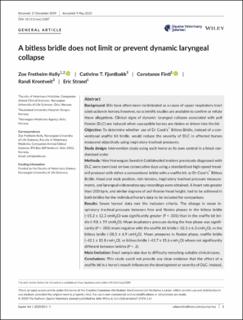| dc.contributor.author | Fretheim-Kelly, Zoe Louise | |
| dc.contributor.author | Fjordbakk, Cathrine T | |
| dc.contributor.author | Fintl, Constanze | |
| dc.contributor.author | Krontveit, Randi | |
| dc.contributor.author | Strand, Eric | |
| dc.date.accessioned | 2020-11-06T10:57:28Z | |
| dc.date.available | 2020-11-06T10:57:28Z | |
| dc.date.created | 2020-05-25T17:32:59Z | |
| dc.date.issued | 2020 | |
| dc.identifier.citation | Equine Veterinary Journal. 2020, 0-7. | en_US |
| dc.identifier.issn | 0425-1644 | |
| dc.identifier.uri | https://hdl.handle.net/11250/2686717 | |
| dc.description.abstract | Background: Bits have often been incriminated as a cause of upper respiratory tract obstruction in horses; however, no scientific studies are available to confirm or refute these allegations. Clinical signs of dynamic laryngeal collapse associated with poll flexion (DLC) are induced when susceptible horses are ridden or driven into the bit. Objective: To determine whether use of Dr Cook's™ Bitless Bridle, instead of a conventional snaffle bit bridle, would reduce the severity of DLC in affected horses measured objectively using inspiratory tracheal pressures. Study design: Intervention study using each horse as its own control in a block randomised order. Methods: Nine Norwegian Swedish Coldblooded trotters previously diagnosed with DLC were exercised on two consecutive days using a standardised high-speed treadmill protocol with either a conventional bridle with a snaffle bit, or Dr Cook's™ Bitless Bridle. Head and neck position, rein tension, inspiratory tracheal pressure measurements, and laryngeal videoendoscopy recordings were obtained. A heart rate greater than 200 bpm, and similar degrees of poll flexion/head height, had to be achieved in both bridles for the individual horse's data to be included for comparison. Results: Seven horses’ data met the inclusion criteria. The change in mean inspiratory tracheal pressure between free and flexion phases in the bitless bridle (−15.2 ± 12.3 cmH2O) was significantly greater (P < .001) than in the snaffle bit bridle (−9.8 ± 7.9 cmH2O). Mean inspiratory pressure during the free phase was significantly (P < .001) more negative with the snaffle bit bridle (−32.3 ± 6.3 cmH2O), vs the bitless bridle (−28.5 ± 6.9 cmH2O). Mean pressures in flexion phase, snaffle bridle (−42.1 ± 10.8 cmH2O), vs bitless bridle (−43.7 ± 15.6 cmH2O) where not significantly different between bridles (P = .2). Main limitation: Small sample size due to difficulty recruiting suitable clinical cases. Conclusions: This study could not provide any clear evidence that the effect of a snaffle bit in a horse's mouth influences the development or severity of DLC. Instead, head and neck angles induced by rein tension seem to be he key event in provoking DLC in suspectible horses. | en_US |
| dc.language.iso | eng | en_US |
| dc.rights | Attribution-NonCommercial-NoDerivatives 4.0 Internasjonal | * |
| dc.rights.uri | http://creativecommons.org/licenses/by-nc-nd/4.0/deed.no | * |
| dc.title | A bitless bridle does not limit or prevent Dynamic Laryngeal Collapse | en_US |
| dc.type | Peer reviewed | en_US |
| dc.type | Journal article | en_US |
| dc.description.version | publishedVersion | en_US |
| dc.source.pagenumber | 0-7 | en_US |
| dc.source.journal | Equine Veterinary Journal | en_US |
| dc.identifier.doi | 10.1111/evj.13287 | |
| dc.identifier.cristin | 1812518 | |
| dc.relation.project | Norges forskningsråd: 311955 | en_US |
| cristin.ispublished | true | |
| cristin.fulltext | original | |
| cristin.qualitycode | 2 | |

